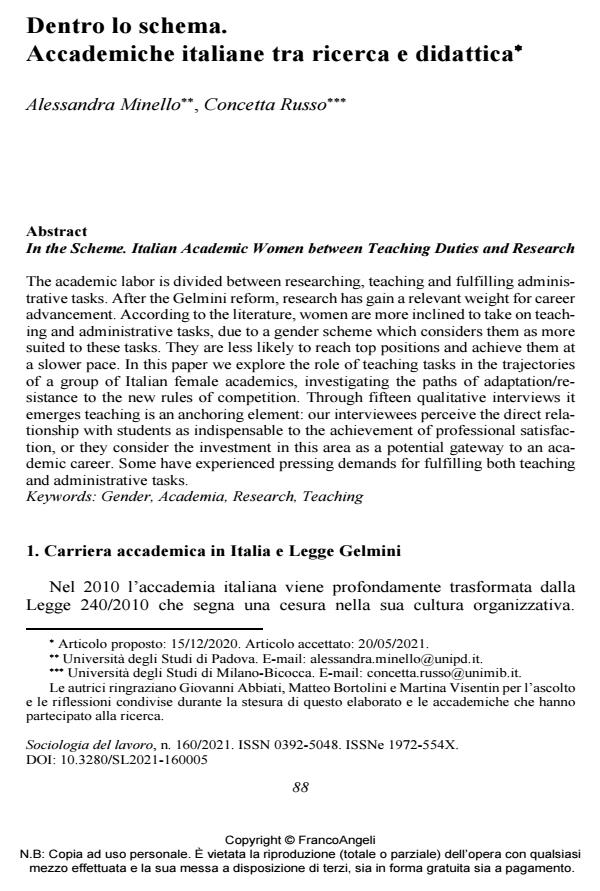Dentro lo schema. Accademiche italiane tra ricerca e didattica
Titolo Rivista SOCIOLOGIA DEL LAVORO
Autori/Curatori Alessandra Minello, Concetta Russo
Anno di pubblicazione 2021 Fascicolo 2021/160
Lingua Italiano Numero pagine 22 P. 88-109 Dimensione file 262 KB
DOI 10.3280/SL2021-160005
Il DOI è il codice a barre della proprietà intellettuale: per saperne di più
clicca qui
Qui sotto puoi vedere in anteprima la prima pagina di questo articolo.
Se questo articolo ti interessa, lo puoi acquistare (e scaricare in formato pdf) seguendo le facili indicazioni per acquistare il download credit. Acquista Download Credits per scaricare questo Articolo in formato PDF

FrancoAngeli è membro della Publishers International Linking Association, Inc (PILA)associazione indipendente e non profit per facilitare (attraverso i servizi tecnologici implementati da CrossRef.org) l’accesso degli studiosi ai contenuti digitali nelle pubblicazioni professionali e scientifiche
Il lavoro accademico si divide tra ricerca, didattica e attività amministrative. Dopo la riforma Gelmini, la ricerca ha un peso rilevante ai fini dell’avanzamento di carriera. Secondo la letteratura, le donne sono più propense ad assumersi i compiti di insegnamento e quelli amministrativi, in virtù di un gender scheme che le vede più portate per queste mansioni. Le donne hanno meno probabilità di raggiungere posizioni apicali e le raggiungono più lentamente. In questo articolo esploriamo il ruolo attribuito dalle accademiche italiane ai compiti di didattica, indagando i percorsi di adattamento/resistenza alle nuove regole di competizione. Attraverso quindici interviste qualitative emerge che la didattica è considerata un elemento di ancoraggio: le intervistate percepiscono il rapporto diretto con gli studenti come indispensabile al raggiungimento della soddisfazione professionale, o considerano l’investimento in questo ambito come una potenziale porta di accesso alla carriera accademica. Alcune hanno subito richieste pressanti sia per l’espletamento di compiti di didattica sia amministrativi.
Parole chiave:genere, accademia, ricerca, didattica
- Etnografia a distanza o etnografia digitale? Una riflessione metodologica su uno studio etnografico tra le lavoratrici accademiche italiane mediato dalle Ict Concetta Russo, in SOCIOLOGIA E RICERCA SOCIALE 127/2022 pp.43
DOI: 10.3280/SR2022-127003 - Gender Inequalities in Academia: Multiple Approaches to Closing the Gap Emanuela Lombardo, Manuela Naldini, Barbara Poggio, in SOCIOLOGIA DEL LAVORO 168/2024 pp.9
DOI: 10.3280/SL2024-168001 - You have to work more than men to succeed! Gender differences in workaholism among Italian academics Giulia Tattarini, Renzo Carriero, Cristina Solera, in SOCIOLOGIA DEL LAVORO 168/2024 pp.28
DOI: 10.3280/SL2024-168002
Alessandra Minello, Concetta Russo, Dentro lo schema. Accademiche italiane tra ricerca e didattica in "SOCIOLOGIA DEL LAVORO " 160/2021, pp 88-109, DOI: 10.3280/SL2021-160005